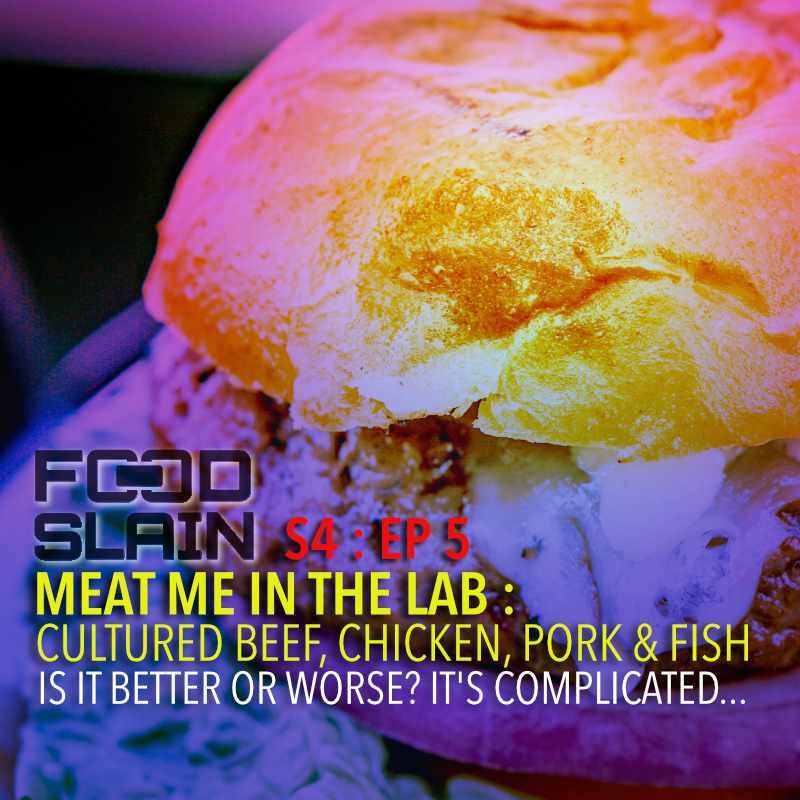Today, we’re talking about lab grown meat.
Also known as in-vitro meat, and “franken-meat”. Throughout this episode, I’ll be using some of these terms interchangeably, but for the most part I’ll be using the name that consumers think sounds the best, cultured meat.
First, I want to thank two of my listeners, Yvonne and Vincent who both sent me this topic suggestion. I love hearing from my listeners, so a big Thank You to both of you for listening in and suggesting this very interesting and complicated topic. If you’d like to hear about a specific food, ingredient, or food supply chain issue – HOLLA! Connect with me on the socials @foodslain and let me know.
Thank you to all of my listeners out there who appreciate this content, and if you do too, please consider supporting this podcast by making a one-time donation on the website, or supporting me on Patreon. I truly appreciate you sharing these episodes with the people you love, because the more you know…the better decisions you can make about what goes onto your plate.
So, what is cultured meat, exactly?
Lab grown meat is made from animal stem cells taken from real animal muscle tissue, then it’s fed a cocktail of enzymes, amino acids, vitamins, salts, glucose and set into fetal bovine serum to continue to grow.
This new technology is being lauded as a solution to the greenhouse gasses that CAFO’s (concentrated animal feeding operations) produce each year. CAFO’s are those large confined operations where thousands of animals spend their lives confined and often mistreated for our consumption. Vegans, animal and environmental activists and many people like you and me care about the ethical treatment of animals. People care about reducing greenhouse gasses (specifically highlighted in the production of beef) – you know, the cow farts they say that are causing climate change. People who just want to see a more just and equitable food system, consider cultured meat as a breakthrough technology that can combat some, if not all of these issues.
When it comes to a reduction in greenhouse gasses…sure, cultured meat looks like a good solution.
There are several studies that show cultured meat production significantly reduces greenhouse gasses from methane and it is significantly lower in land use over any other animal production – which is good, right? But the current challenges with the production of cultured meat from an environmental perspective is focused more on energy use. A study in 2014 found that cultured meat production actually exceeded the energy use of beef production and also exceeded water use of poultry production. And by energy use, we’re not talking about renewable energy – we’re talking good ol’coal – so in the long-term, emissions from these labs could likely exceed energy use in conventional animal agriculture.
Just so we’re clear, cultured meat isn’t a new thing.
In 1912, scientist Alex Carrel managed to keep cells from an embryonic chicken heart alive in a nutrient bath, alive for 20 years! Even in the early 1930’s, Winston Churchill wrote in an essay with the prediction that we would escape the “absurdity of growing a whole chicken in order to eat the breast or wing, by growing these parts separately in a suitable medium.” This idea has been around for more than a century, but in the past decade, more and more companies are reviving it and getting into the business of cultured meat.
As of this recording, there are at least 37 startup businesses around the world creating cultured meat products, like beef, chicken, pork and fish. There are companies working on creating other cultured dairy products like milk and eggs, and for those of you who enjoy the finer things in life, there’s even a company working on creating a lab grown version of foie gras – aka really expensive duck or goose liver.
So, the question we’re digging into today is, is cultured meat production better or worse than traditional animal production?
It’s complicated, but meet me in the lab and let’s dig in.
Okay….so where do we start with this very complicated food and business model. There are many pros and cons to cultured meat. Scientists have been dabbling in cultured cells for 100 years now, and the first lab grown meat company was started in Eastern Canada on Prince Edward Island called AquaBounty, by scientist Garth Fletcher in the 1980’s. He started this company because he realized that overfishing was becoming a problem, for people and animals. He realized that salmon was a critical food for bears and whales. Overfishing is still a big problem and our consumption has grown exponentially, which is why we have farmed fish which has its own set of challenges. If you haven’t listened to my episode on fish, check out Season 2 Episode 5.
So, if we start with the ethical and moral issues, we know that many of these cultured lab meat companies are basically good people who want to do good. Part of that doing good is creating a product that reduces animal cruelty. It is a well known fact that animal cruelty is rampant in conventional animal agriculture. This is a crucial issue for many vegans, vegetarians, and animal activist organizations like PETA and Mercy for Animals who have repeatedly exposed the egregious treatment of animals that are raised for our consumption. This new technology boasts saving millions (maybe billions) of animals as one reason for moving forward, but the question is…
Does cultured/in vitro meat really save animal lives?
Let’s talk about that. So, the way cultured meat is made is in-vitro, in a lab. It requires several components to make it possible, including animal stem cells, vitamins, minerals, salt, sugars and the most critical element for this magical meat to happen, a serum solution called fetal bovine serum or FBS. Now fetal bovine serum isn’t broadly discussed because a lot of these companies do not offer much transparency – probably because it is just as, if not more controversial than animal agriculture.
If you’re asking yourself, what fetal bovine serum is, you’re not the only one. According to a study done in 2002 that lifts the very secretive veil on what FBS is, which is, fetal bovine serum is basically the heart blood of a three month old unborn unanesthitized cow fetus that is still inside its pregnant mother. It seems that the mother is killed, the fetus is removed while it is still alive, then the blood from its heart is harvested and then the fetus is made into other animal feed products. What’s even more startling is, to continue making cultured meat at any scale that could replace current animal consumption, would require anywhere between 1-2 million fetuses each year. Yeah, only 1-2 million unborn calves and their mothers have to be slaughtered but, whatevs. Talk about animal cruelty.
So, ethically speaking, is it better to slaughter 2 million calves and their mothers or is it better to allow many more millions of animals to live out their lives on antibiotics in CAFO’s? It’s a good question. What do you think?
But let’s move onto the health benefits or not, of cultured meat.
It’s true that ecoli and salmonella exposure is pretty high as a result of slaughtering billions of animals. The CDC reported that by December of 2019, 102 people from 23 states had been infected by ecoli and 1003 people from 49 states had been infected by salmonella. These numbers include ecoli from unwashed lettuce recalls, as well as the surge in people keeping backyard chickens. So, it’s possible that human exposure to ecoli and salmonella might be reduced with the introduction of cultured meat because we wouldn’t be dealing with animal excrement in the water, soil and air, right?
I mean, most animals in CAFO’s are sick and many of them need antibiotics their entire lives.
Here’s a quote from the Atlantic that I found :
“For now, though, lab-grown meats still require the use of antibiotics. In conventional meat production antibiotics are given routinely to healthy animals to promote growth. They are used so freely, that according to the Food and Drug Administration, they now constitute 72 percent of all U.S. antibiotic sales. This, in turn, can lead to the emergence of resistant bacteria. Post’s lab-grown beef required antibiotics, too. “Cultured muscle has no immune system, so it was necessary. In the future, once production is scaled up and automated, it could be done in closed sterile systems so the antibiotics will no longer be needed,” he says.”
So when we’re talking about animal agriculture, the continued use of antibiotics is responsible for other externalities that affect animals and humans, which according to the World Health Organization, “leads to higher medical costs, prolonged hospital stays and increased mortality.”
But guess what? From what I can tell, right now, cultured meat is required to use antibiotics because this lab grown meat has no immune system like animals. That may change, but who knows. Labs in general have to stay pretty clean and sterile, and when you’re growing cells to make meat, there’s probably some chance that antibiotics might be necessary to maintain those conditions. Maybe not, but I guess we’ll see.
On the bright side, cultured meat doesn’t contain saturated fats, there’s no heme iron and there are no growth hormones used in the production of cultured meat, so that could be a benefit if we’re talking about health outcomes. Additionally, cultured meat unlike real meat, isn’t exposed to feed inputs like GMO corn, soy, wheat and other chemicals in conventional animal feed products – and that’s a real plus. Well, for now at least. There are many other “meat substitutes” entering the marketplace that ARE using those exact feed inputs.
But, let’s look at environmental impacts of lab grown meat, shall we?
We talked briefly about greenhouse gasses that cows produce, and cultured meat doesn’t produce methane, so there would be a very significant impact there. However, many studies estimate that if we scaled up the production of cultured meat, the factories would eventually create more carbon emissions than the production of beef and would use more water resources than the production of poultry.
Of course, lab grown meat would also significantly reduce the amount of land needed to raise animals for consumption. When we look at fish, lab grown fish would tackle the overfishing problem and would basically reduce the amount of mercury and microplastics that are found in fish from every body of water in the world. And it would dramatically reduce the number of imports of seafood that we rely on for our consumption. Imported seafood is a billion dollar industry and many Asian countries rely on that trade income for their economies. I talk about some of that in my fish episode – so go and check that out. But all of these benefits are good things that would help reduce the environmental impact of raising meat for food. That’s tasty…
But GMO fish grow bigger and faster, and they use genetic mutations to keep hormones running all year long.
There are many other potential environmental impacts concerning day-to-day operations of these labs – like energy use, the manufacturing of millions of single use plastics (like sterile gloves, petri dishes, syringes, and of course, packaging. I mean currently, most meat is packaged in plastic and styrofoam, so there doesn’t seem to be much of an environmental net gain there.
Let’s pivot to the economics of cultured meat.
First, let’s talk about the costs. So cultured meat is really really expensive to create at this small scale. The very first cultured meat burger cost $280,000 to produce, but there is a lot of talk about the costs coming down to about $10. Costs are high whenever you start a new venture. You’ve got typical business expenses like operating costs, payroll, you have to invest in infrastructure and so on. And it’s not uncommon for a bio-tech startup to raise a few million dollars to get things up and running, right? Well, here’s some numbers for you…hold onto your buns…
Like I mentioned, I found at least 37 companies in the lab-grown meat business and many of these companies have gone public, which means their company’s shares are publicly traded on the global stock market – and stock prices are bullish and on the rise. But here are a few of the top dawgs in the game. There’s Memphis Meats, out of Berkeley, CA. They have raised $161M in funding from billionaires like Bill Gates and Richard Branson and multi-billion dollar corporations like Cargil and Tyson Foods. There’s Mosa Meat, a Dutch-based food company which introduced the first cultured meat burger back in 2013. They’ve raised $55M and one of its early funders was Sergiy Brin, one of Google’s founders; There’s Future Meat based in Isreal and they’ve raised $14M with the help of Tyson Foods; and there’s Blue Nalu (one of the companies creating culture fish products) and they’ve raised $24 million, which boasts on its website that its “investors originate from Brazil, Hong Kong, Israel, Japan, Luxembourg, Netherlands, Saudi Arabia, South Korea, Sweden, United Kingdom and the United States.”
So, clearly, there’s something here. Private investors, big agriculture, bio-tech, multi-national billion dollar companies are all trying to get a piece of the pie…or burger or chicken…or fish. You get the jist. They are pouring millions of dollars into an industry that hasn’t even proven itself in the marketplace yet.
Which brings us to the question…will people buy it?
Many of these investors are hoping that cultured meat is more than a replacement for animal meat. It’s likely there will be early adopters but the target is on China’s back…there’s a market of a billion people there and one of the social or cultural markers of a society on the rise is the consumption of meat. Another things is, these companies recognize that the concept of lab-grown meat is a difficult hurdle for consumers to over come. That’s why they’ve spent money on research focus groups which revealed that people don’t want to eat something called “lab grown” or “in vitro” meat…they want “cultured meat”. It just sounds better.
Then there’s the marketing. There will have to be an expensive marketing push to help educate consumers about the benefits cultured meat is hoping to deliver for the environment. Consumers will also want to know what the risks and rewards are from a health perspective. But the truth is, we just don’t know yet whether these products will benefit our health at all. I mean, it is after all, still a genetically modified food. And GMO’s can alter our DNA and gut microbiome…don’t take my word for it. Just check out my episode with Dr. Tenai The Science Guy on GMO corn and genetics…
The irony here is, cultured meat is being pushed as something that solves problems, but it seems to create quite a few problems of its own. This isn’t a vegan food because it still uses animal cells. However I did find a few articles on companies that were looking into other plant based cells that could replace animal stem cells…but would we still need fetal bovine serum? Dunno.
We haven’t even talked about regulatory compliance issues for human consumption and also for pet food…there’s a huge market for a product like this that can feed our dogs and cats.
And, we haven’t talked about the corporate control of this food.
When there are only a few who control the industry, it is ripe for abuse, collusion and deception. There are a lot of barriers to entry into this market. You need millions of dollars apparently. It’s not like creating a new type of cracker or nut based cheese. Anyone can do that…but cultured meat is a different game that will be controlled by investors, both foreign and domestic, that are hoping to make money hand over fist once this product hits the market.
Which also brings into question how lab grown meat, which largely rests on the same infrastructure that our current food system is built on, could exacerbate food deserts in low income and rural communities. If this product is supposed to help the environment and be healthier, but it isn’t affordable or accessible, some food justice advocates say that it’s doing just as much harm to food insecure communities as the current industrial food system. These bio-tech startups are being funded by huge agribusiness, Cargill, Tyson, Bill Gates, Richard Branson, and Google…for flock’s sake.
And I want to just point out one more thing…historically speaking, the relationship between man, animals and the land is the foundation of our food supply chain.
Native Americans, for centuries, raised bison on acres and acres of pasture. They did this to feed themselves and be self-reliant. They did this to honor the animals, and they did it to improve the pasture and regenerate the land. There’s no doubt that the relationship between us and our food is in shambles, and it has been interrupted by too many middle-people. We want convenience. We want it all, right now and all the time. But is it possible? Is it better for us? Is cultured meat really better for the environment if we’re using more water and energy to do it? Is it really better for animals if we have to kill unborn baby cows while they are still in their mother’s wombs? Is cultured meat really better for us if only a few of the top players control the manufacturing and distribution of it? Is it really better for us if it’s not really much better than what we’re getting right now? But we have to pay more for it.
Like I said when we started this episode, it’s complicated, but I’ll let you decide.



